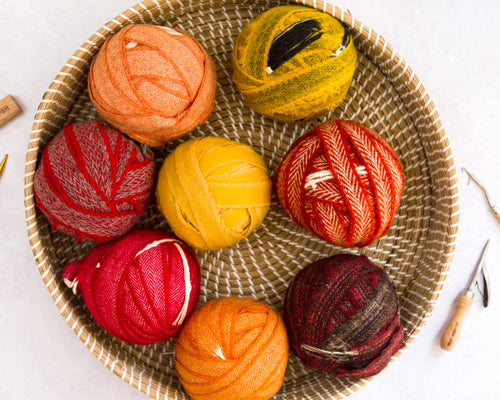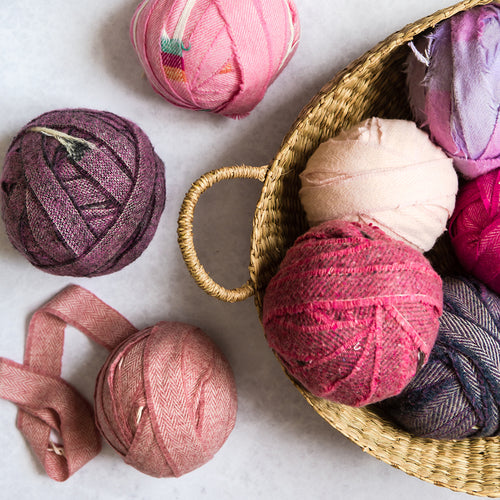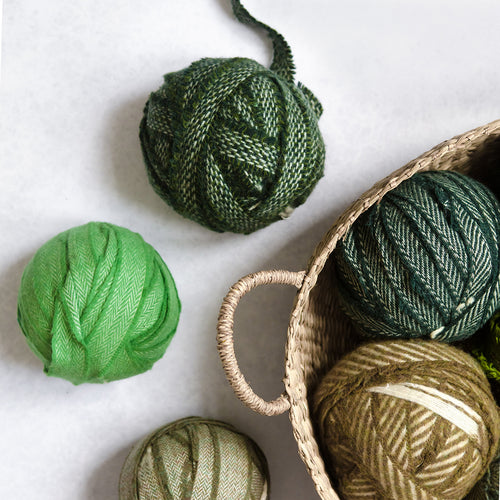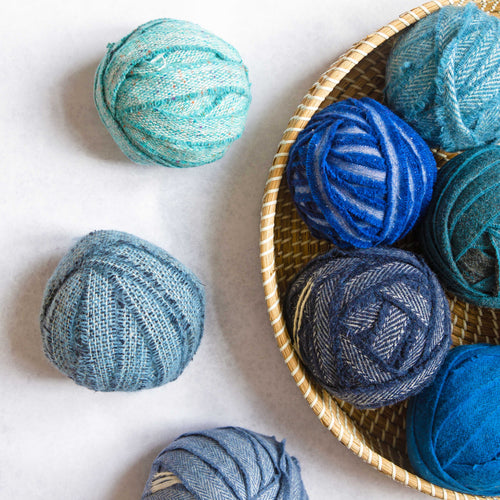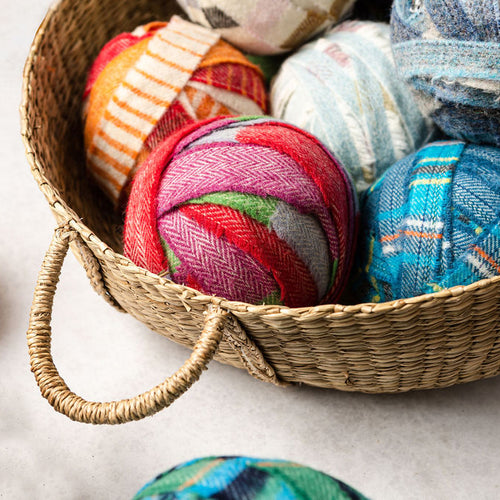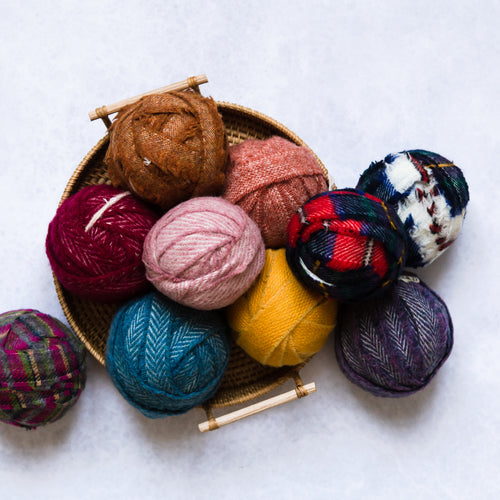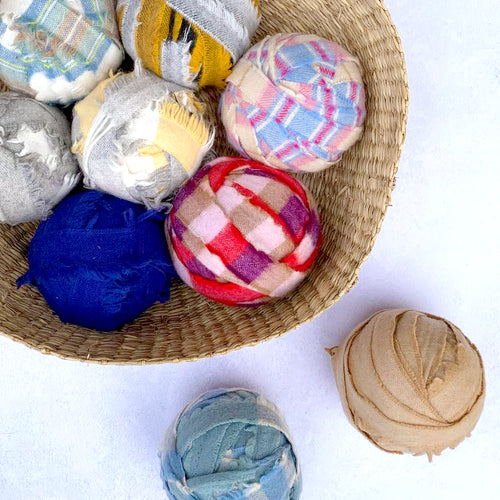Give your old clothes and textiles a new lease of life...
One of the most satisfying features of rag rug making and rug hooking as a hobby is the joy of being able to reach into the wardrobe, take out that old t-shirt you haven't worn for over a decade and turn it into something pretty and practical for the home. There's something doubly satisfying about being able to recognise the fabrics you put into your crafts as ones you've worn or materials that have memories attached.
Rag rugs are made from a whole variety of different fabrics, but some are easier to work with than others. Below we've included some basic beginner advice for when you're selecting fabrics to rag rug and rug hook with.
Psst: Don't worry if you don't have fabrics to work with at home! We've got your covered! Read about our Ragged Life Woollen Blanket Selvedges (which we call "Blanket Yarn") and our Recycled Sari Silk Ribbon below. Before getting started, you may want to familiarise yourself with the different Rag Rug Techniques that exist, as different fabrics lend themselves better to different styles.
The Ultimate Eco-Friendly Craft
The clue is kind of in the name, but traditionally rag rugs are made using old rags. That's to say, old textiles and clothing which has seen better days or is just cluttering up the home.
With that aim in mind, even today we recommend that your first port of call when making a rag rug is to look around your home for unloved materials to repurpose. Rummage out clothing you haven't worn in years, surplus bedding, fat quarters you've hoarded with no plan in mind, socks with no pair - use your imagination and you'll be amazed what you will find!
This will be music to the ears of any dress makers, patchworkers and quilters - even small fabric scraps from other craft projects can be used. For some techniques, the pieces of fabric can be as small as 1 x 3cm (For example, to make our Rag Rug Mini Wreaths), so you'll definitely be able to find a project to use them up regardless of their shape or size.
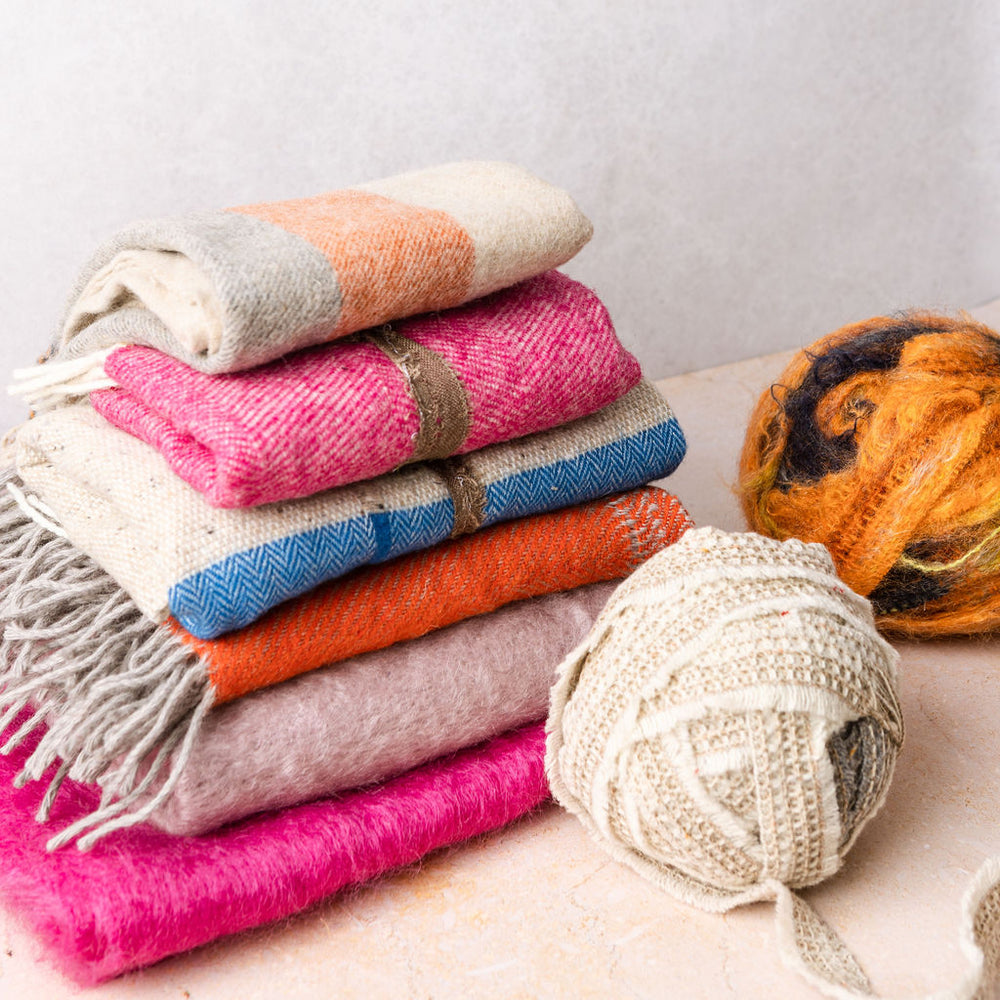
What Can I Use?
Understandably, this is one of the most common questions that we get asked by beginners, new to the craft of rag rug making.
The good news is that if your piece of rag rugging is decorative. For example, a Rag Rug Wreath, Bouquet of Flowers, Christmas Garland etc... then if you can cut a material into strips and if it does not fall apart then it's probably fair game. You can work with sweet wrappers, ribbon, bin bags - whatever your heart desires.
However, true rag rugs and practical pieces such as cushions, draft excluders, pouffes etc... are made using solely fabric so that they can be easily washed. We have a few tips below on what works best...
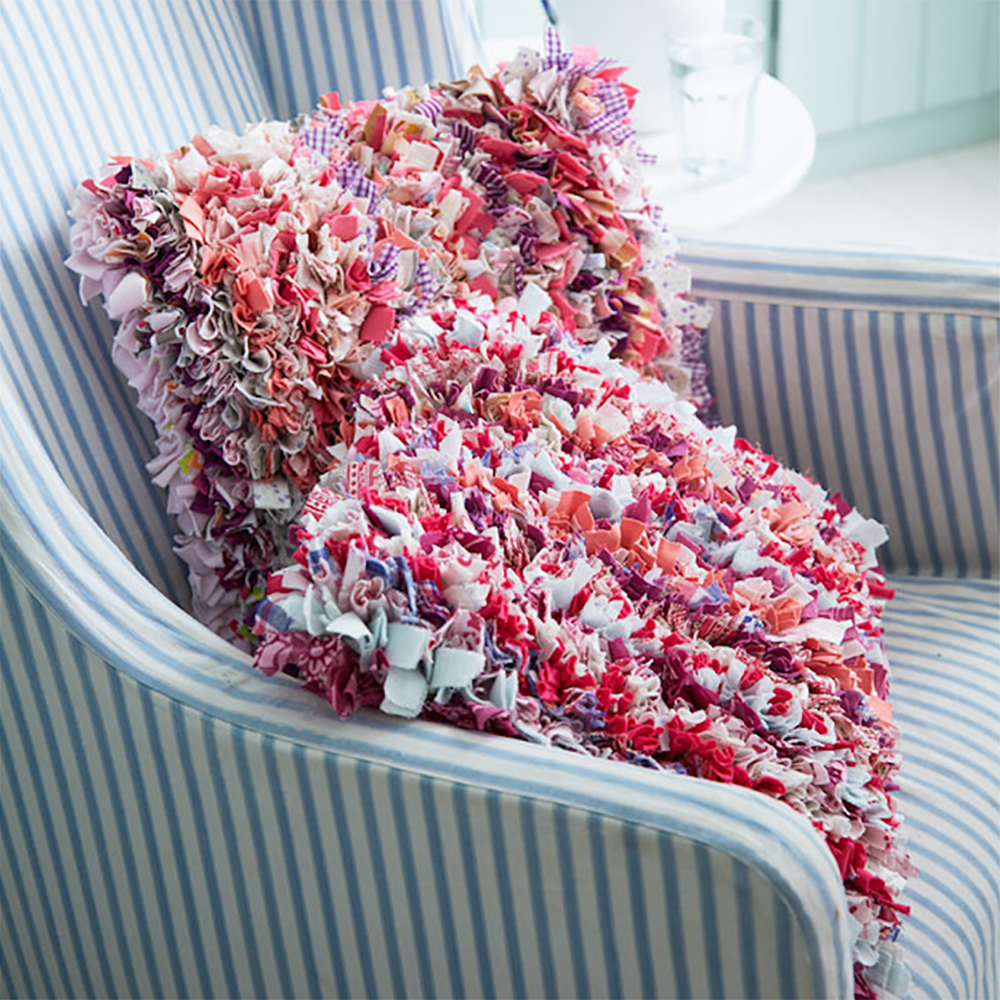
Easy Fabrics to Work With
For most of the rag rug styles out there, the easiest fabrics to work with are ones that are thin, soft and non-textured. For example jersey, fleece, lycra, brushed cotton etc...
Other than our Woollen Blanket Yarn and Recycled Sari Silk Ribbon, I find that the easiest fabrics to rag rug with are old t-shirts, laddered tights, swimwear, fleece, velour and thin cottons. Smooth, pliable fabrics can be easily manipulated so can be used for any classic rag rug technique.
If in any doubt about how easy or hard a fabric will be to work with, cut a tester strip to work with before committing to cutting up the whole item. If you struggle with a fabric that you thought would be easy then sometimes it helps to cut your strips narrower.
Clothing-wise, the larger an item is and the fewest number of seams, the easier it is to deconstruct and therefore easier to work with.
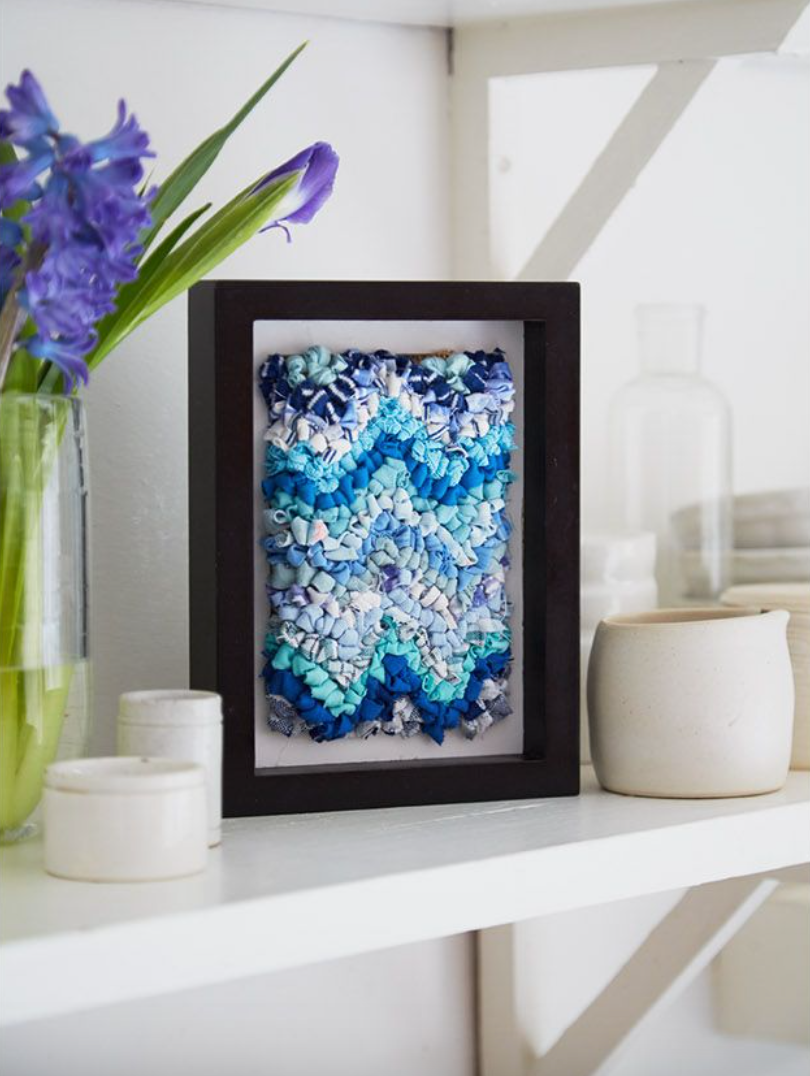
Difficult Fabrics to Rag Rug With
At the other end of the spectrum, difficult fabrics to work with tend to be those that are thick, stiff and textured. For example, thick denim, upholstery material, leather, corduroy, fabrics with stitched designs or kids clothing with plastic printing on.
For the classic British techniques, these fabrics are harder to pull through the small holes in the rug backing and for other styles of rag rugging, thicker, stiffer fabrics are harder to bend into shape e.g. when Rug Twining, Coiling around Cord or Braiding.
However, rag rugging is all about texture, so if I love a particular fabric I will generally tough it out and make it work. Usually, you can cut trickier fabrics into narrower strips to make them easier to work with.
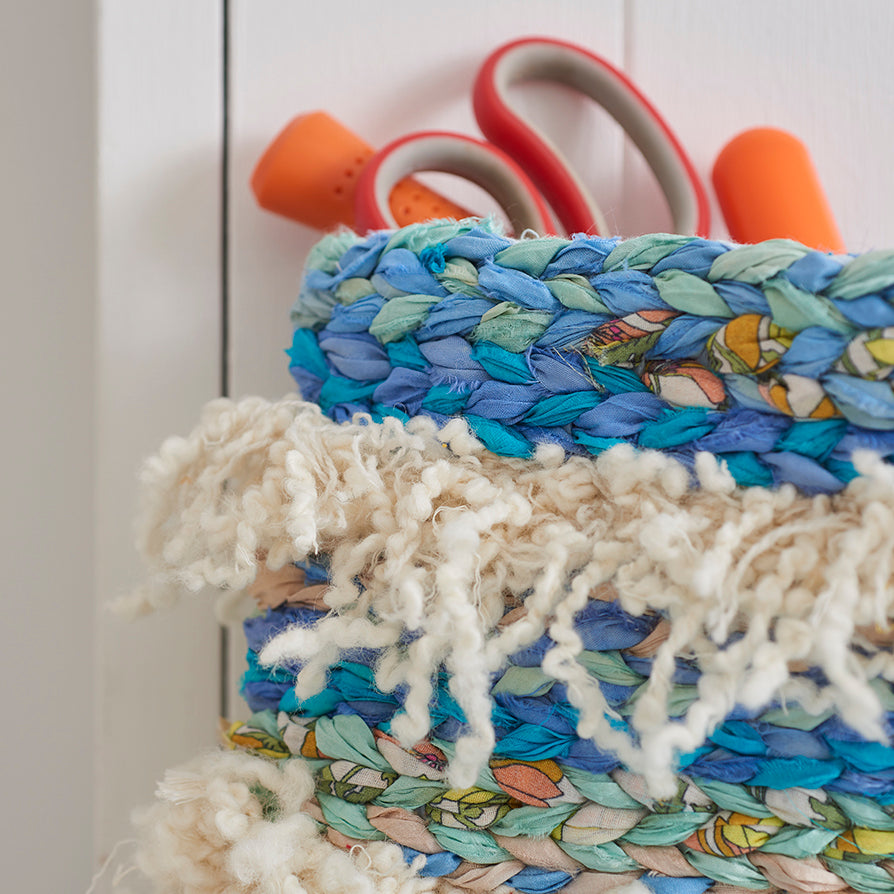
Avoid Fabrics that Shed Too Much & Fall Apart
Most rag rug techniques involve first cutting fabric into strips - these could be long strips or short strips. This process leaves the edges of the fabric raw and vulnerable to ravelling (falling apart) and shedding.
Most fabrics shed a little bit when you cut them into strips. For example, you may see some fibre and fluff when you cut up jersey, cotton, velour etc... But eventually these fabrics stop shedding and look great in your project.
However, other fabrics never stop shedding and you'll be forever vacuuming around your rag rug if you use too much. Once cut into strips, these fabrics have hairy, roughed up edges which can look messy and be disappointing if you're not sure what to expect.
Fabrics that shed a lot and I tend to avoid if possible are heavy upholstery materials, satin polyester, towels. certain linens and loosely knitted jumpers.
If in doubt, cut a tester strip before committing to cutting up a whole garment.
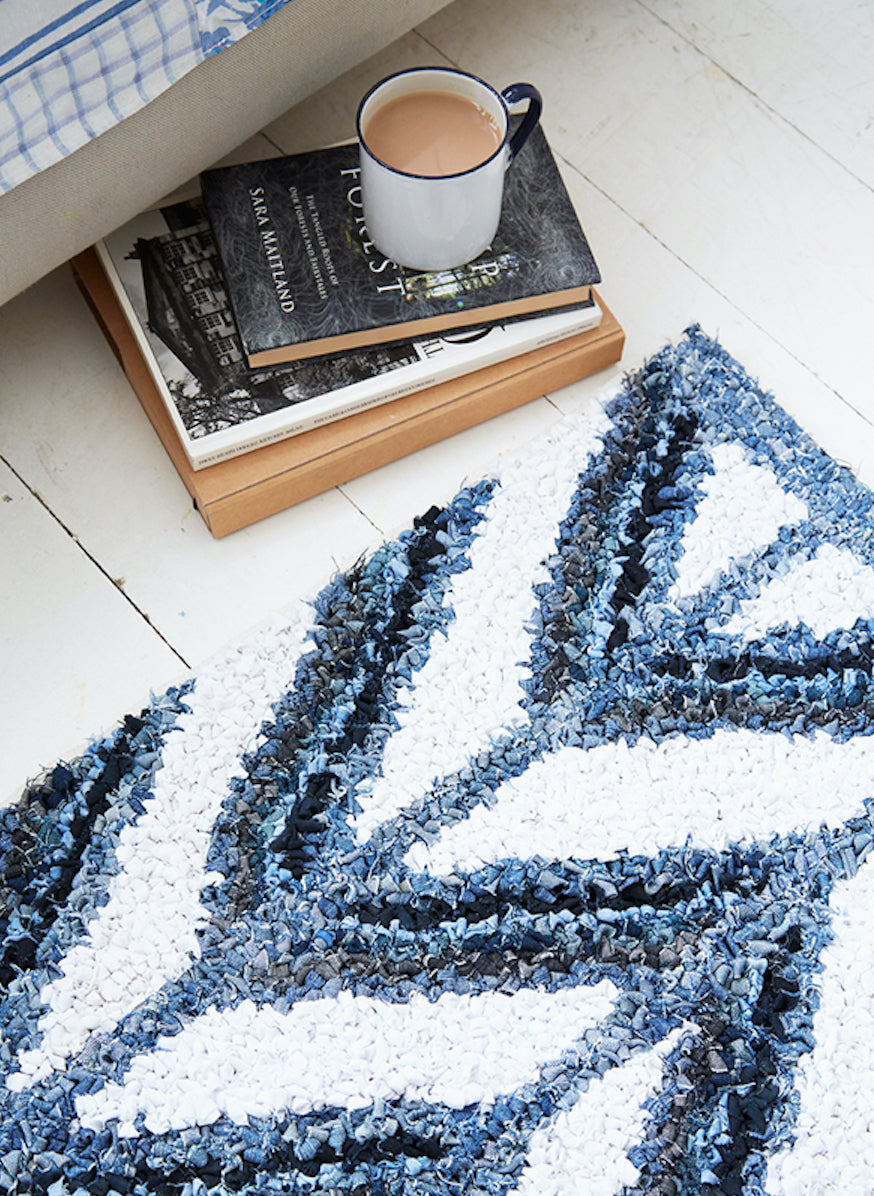
Mixing Different Fabrics Together in a Rag Rug
In some crafts, it can be technically very difficult to combine lots of fabrics together into one piece without it ending up looking like a dog's dinner. In rag rug making, we buck the trend and often mix together a whole variety of different fabrics in one piece. We believe that this variety of textures makes your creation look more interesting and it allows you to use up materials which you already have, which is at the heart of rag rug making.
If your design is looking quite flat then adding a fabric with interesting texture, such as lace, chiffon, voile or jersey (which tubes up) can lift the design and make it more vibrant.
Colours are more important than texture, so bear that in mind when choosing fabrics.
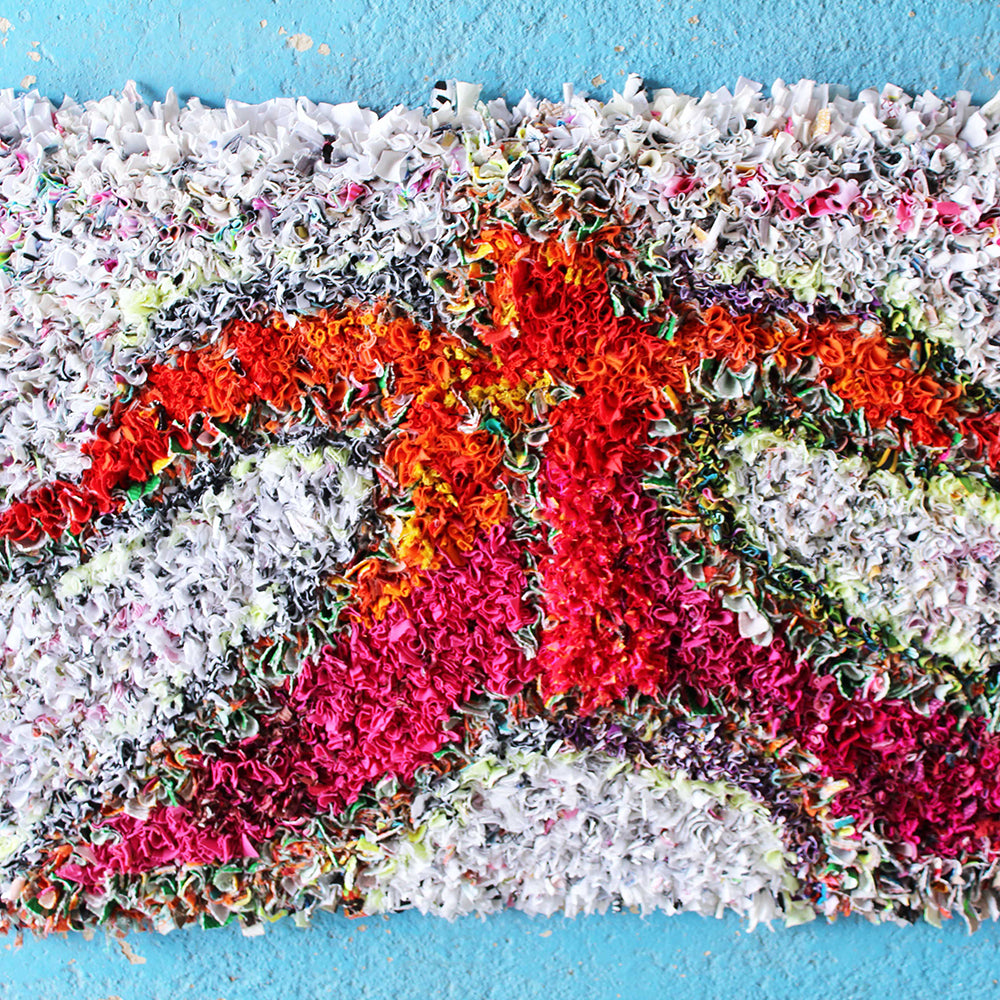
What Can't I Use From a Garment?
If you have perfectly flat fat quarters or metres of fabric to use in your rag rug then lucky you! However, chances are that you will be working with old clothing which first needs deconstructing.
Below you can watch a video on how to break down clothing into strips of fabric, but here are a few tips on what you can and can't use.
1) Seams & Hems. You can generally work with seams for most techniques of rag rug making as long as the seams run in line with your strips, not horizontally across them. This way the seam stitching looks like interesting detail, rather than a lumpy knot part way through a strip. People see the colour of the fabric, not the fine details.
2) Pockets. These generally work themselves out as you cut up a garment into strips, so there's no need to cut them out before you cut the piece of clothing into strips.
3) Button strips and collars. You can usually get some usable strips out of these areas of a garment, but it depends how determined you are. I like to keep small, difficult parts of clothing in reserve to make strips out of just in case I run out of a specific colour.
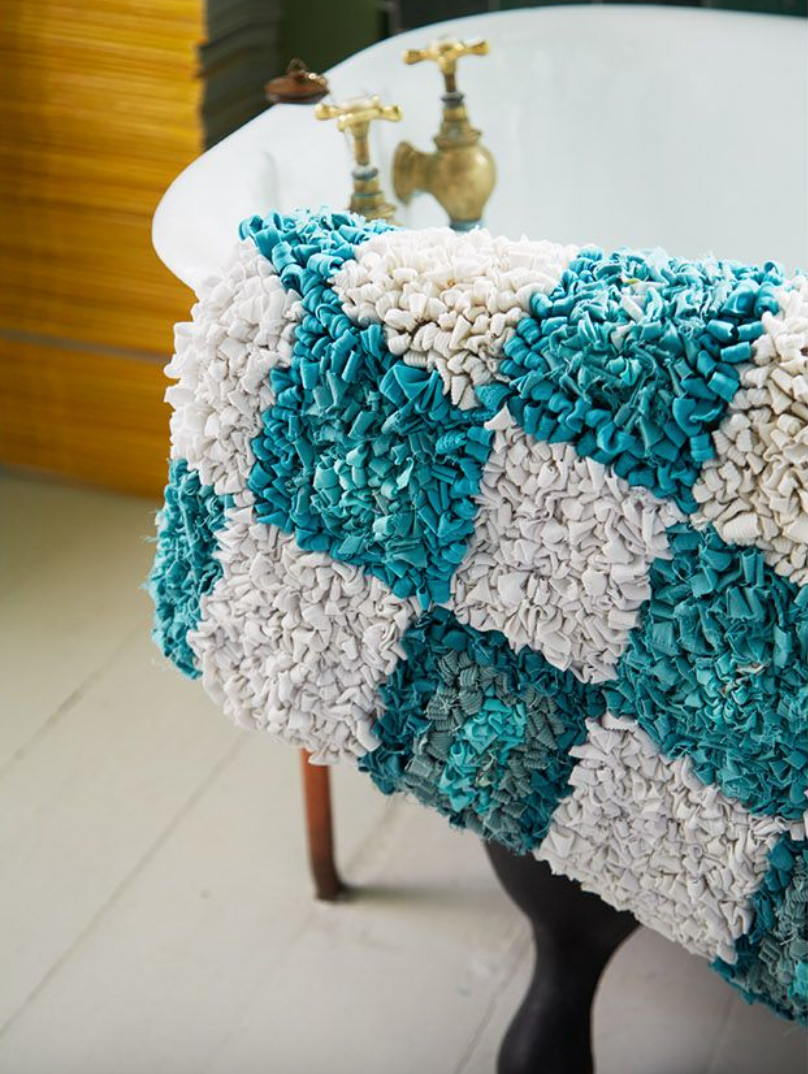
How to Prepare Fabric for a Rag Rug
Here you can view our step by step video tutorial and how to break down clothing into the strips.
The same steps can be followed for most rag rug techniques, however the width that you cut the strips and the length that you leave them varies.
The larger the item of clothing, with the least number of seams, the easier it is to break down into strips. Unfortunately you don't get much fabric from a cute baby grow, no matter how adorable they are!
Technique-Specific Advice
- The shaggy (proggy) and short shaggy techniques use short strips of fabric. As all four sides of the strips are raw and exposed, avoid fabrics that shed too much (see above section).
- The loopy, rug hooking technique works best with soft, pliable strips as they are easiest to form into loops.
- Peg loom weaving uses long strips, so ideally work with some large pieces of fabric, such as bedding, otherwise you'll be doing a lot of joining! Avoid fabrics with too much stretch and elasticity.
- The Coiled Cord / Rope Technique works best with thinner fabrics as thick fabrics can be too bulky when overlapped and bunch up on the cord. The length of strips doesn't really matter.
- Locker hooking works similar to rug hooking, so soft, pliable strips work best.
- Rug Twining - avoid stretchy fabrics as these can warp the shape of the rag rugging once it is taken off the loom.
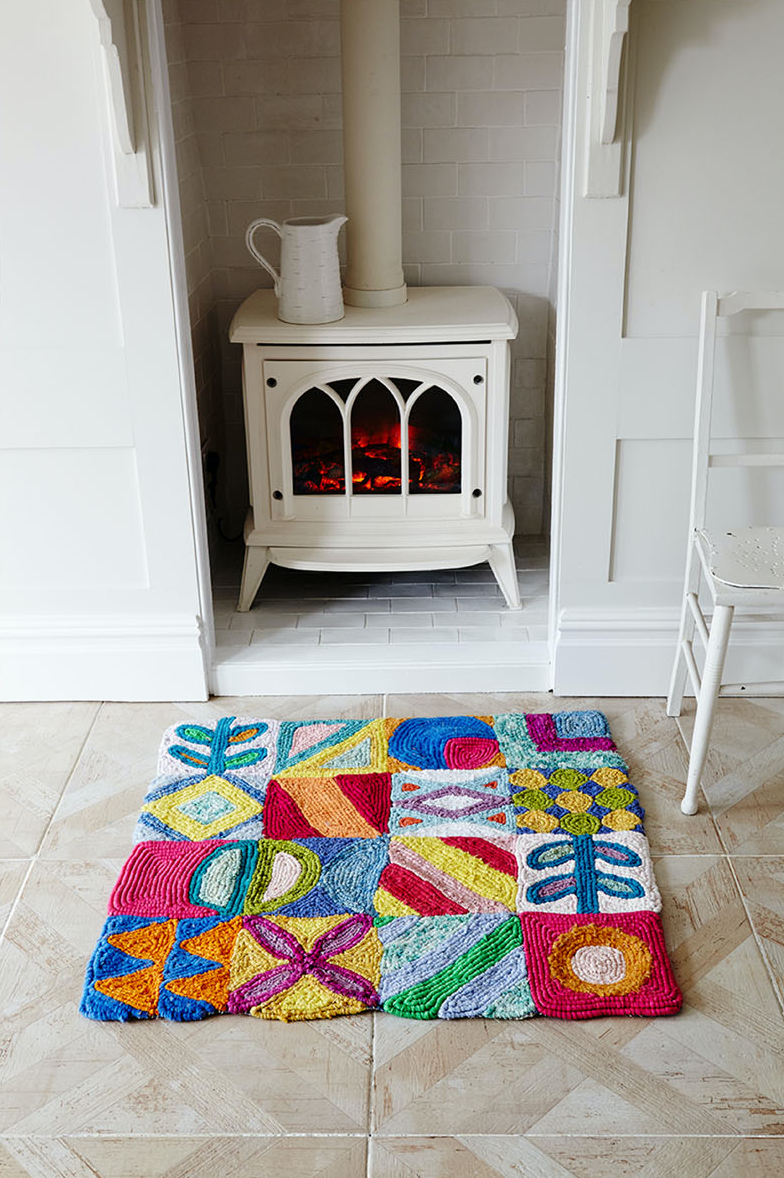
Not sure what fabrics you've got lying around at home? Or perhaps you're looking for specific colours, quality woollen material or pre-cut strips?
One of our most popular products on the Ragged Life site is our 100% Wool Blanket Selvedge strips - "Blanket Yarn" as we call it. It's easy to work with and perfect for taking your rag rug making to the next level. Read on below for a brief intro to the product...

Ragged Life Woollen Blanket Selvedges
If you don't have much clothing and fabric stashed away at home, or perhaps you want to make a traditional woollen rag rug, then we've got you covered. For the past few years, we've been working with the British woollen mills to save strips of blanket from ending up in landfill.
We ball these colourful blanket selvedges up into 250g balls which we then sell on the Ragged Life Online Shop.
Below has a bit more information about what our Ragged Life "Blanket Yarn" is, how to use it and how much you may need for a specific project.
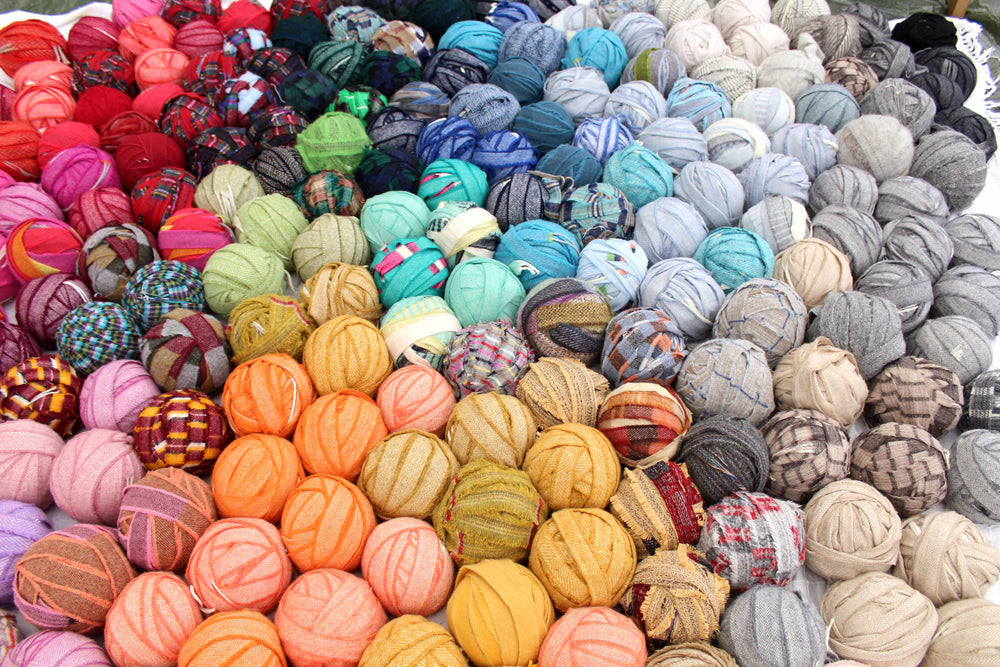
What is Blanket Yarn?
Blanket yarn is the poshest textile waste you could hope for.
When blankets and scarves are woven in the mills in the UK, during the finishing process, a strip is cut off both sides of the blanket material to give it a clean, uniform finish. These selvedge strips of blanket and scarf which are left are what we call "Blanket Yarn". It's 100% wool, top quality and is a dream to craft with.
We source woollen selvedges from a number of different mills, so they vary in the wool used (e.g. they could be cashmere, lambswool, mohair etc...), width of strip, quantity and colour. We may see a lot of a colour or pattern one year, but then never again. Trends change!
When we pick up the blanket yarn from the mills, it comes in tonne bails which the Ragged Life team sort through in the studio, before balling up into 250g balls. These balls are then sold in different colourways on the Ragged Life Online Shop.
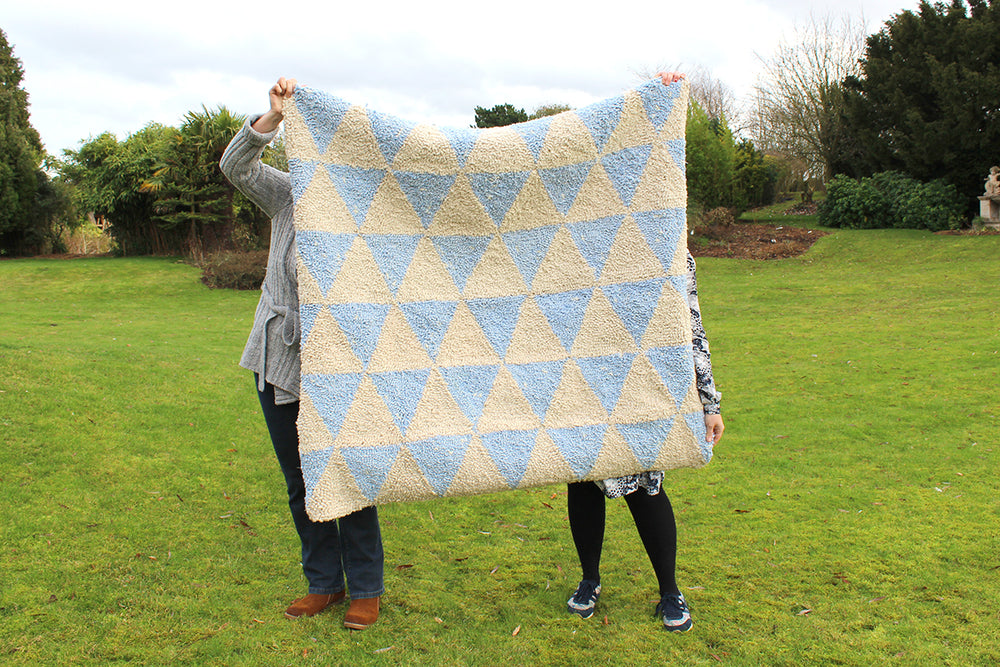
Woollen Selvedges - Key Features
- Our blanket selvedges vary in width. They could be anywhere between 1.5 and 4cm in width depending on what mill they have come from. Most strips are approx 2-3cm in width.
- We generally sell our woollen blanket strips by weight, not length. However, when we measured the continuous length of a few of our 250g balls, they were 30-45 metres long (including the tassels).
- The "yarn" mostly comes in one long, continuous strip. That strip is made up of sections of woven blanket that are joined together by the woollen tassels of the blankets. The blanket sections are 1.5-2 metres in length, joined together by tassels, which are approx 15cm in length. See our video below.
- The fact that our strips are "selvedge" means that the edges of the strips are machine bound so do not shed or fall apart.
- Some blanket yarns are a bit wide to do some rag rug techniques with, so we sometimes recommend cutting strips up the middle lengthways to make them narrower.
- Some blanket yarns are loosely woven so cannot be cut into strips without falling apart. We sell these strips cheaper on the shop as "Weaving Yarn", as they can't be used for quite so many of our techniques. See below for more details.
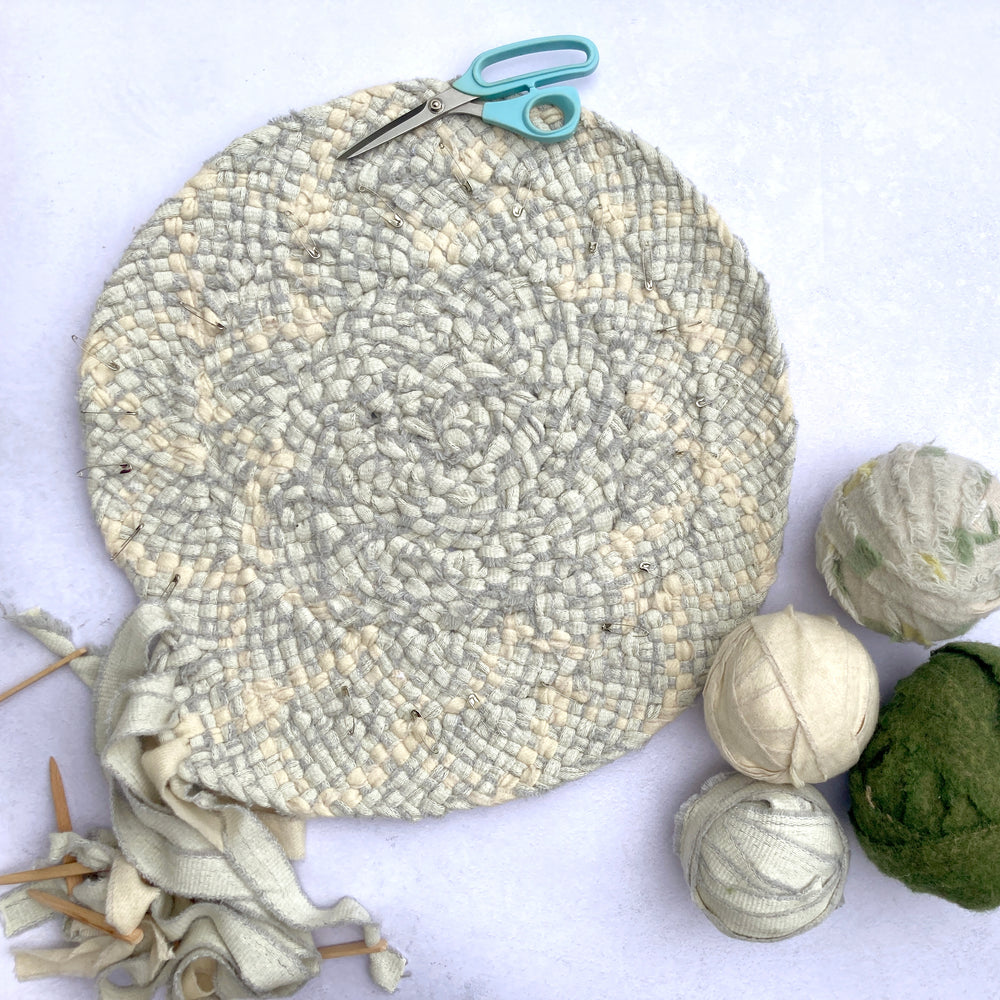
Rug Making with Woollen Blanket Selvedges
If you've been seduced into buying some of our 100% Wool Blanket Selvedges then you're probably looking for a bit of advice on how to prepare and rag rug with them.
Watch our "Rag Rugging with Blanket Yarn" beginners video on YouTube for a visual introduction to the product.
Technique-Specific Advice
- For the shaggy (proggy) and short shaggy techniques, only use blanket yarns that are tightly woven (not weaving yarns).
- The loopy, rug hooking technique works best with narrower strips, so we would generally cut blanket yarn up the middle lengthways to make it easier to work with.
- Peg loom weaving uses long strips, so blanket yarn is one the best fabrics you could hope to work with. We continue weaving even with the tassels.
- The Coiled Cord / Rope Technique works best with thinner fabrics, so blanket yarn isn't ideal for this technique.
- Locker hooking works similar to rug hooking, so cut blanket yarn up the middle lengthways to make it easier to work with.
- Rug Twining - blanket yarn works brilliantly. Fold edges in as you twine (like bias binding) for a super clean look.
- Braid-In Rag Rugs - blanket yarn works brilliantly - see circular example above.
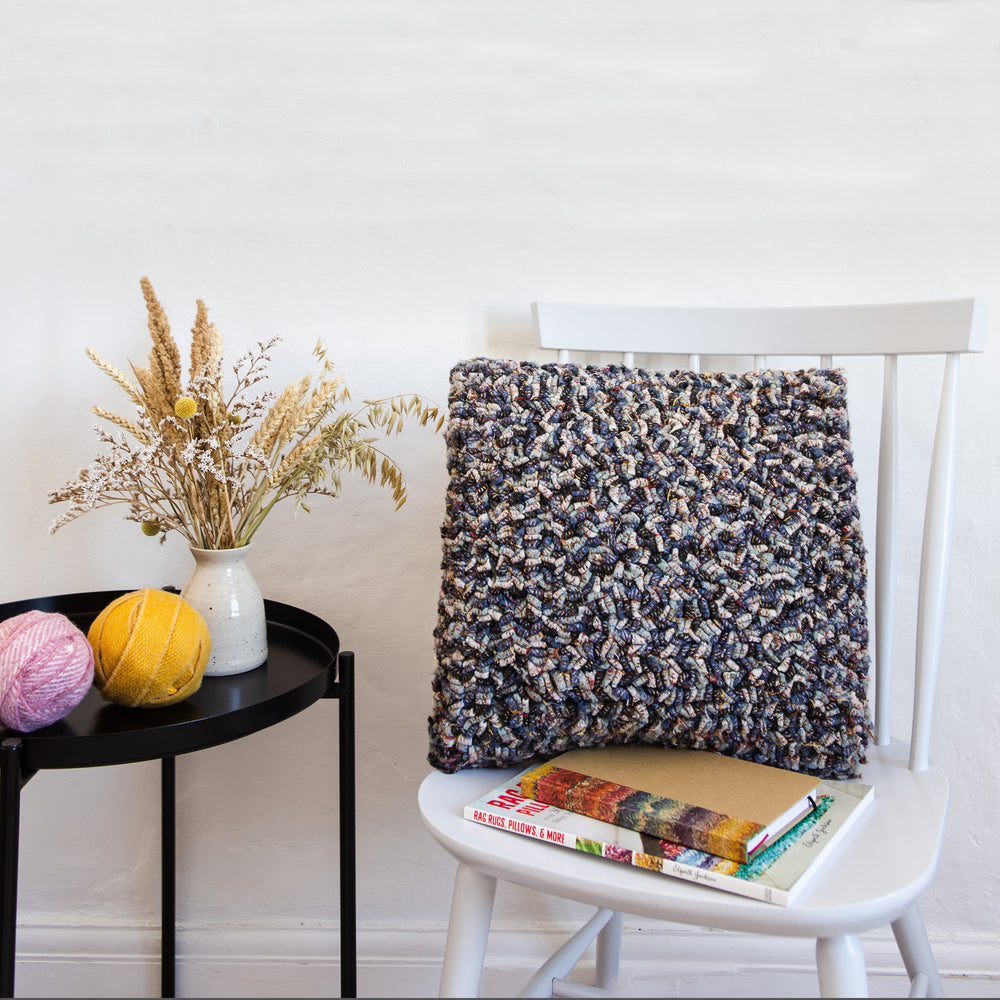
Browse Our Blanket Yarn
Browse our different colourways by clicking through below. The best option for those looking for variety is our 1kg Lucky Dip pack, which consists of 10+ smaller balls of blanket selvedges.
Below are links for our 250g full sized yarns:
- Greens
- Blues
- Neutrals
- 1kg Lucky Dip Pack (10+ smaller balls)
NB: If you're looking for a specific colourway then do get in touch to enquire. Our stock is ever-changing and we may be able to help!
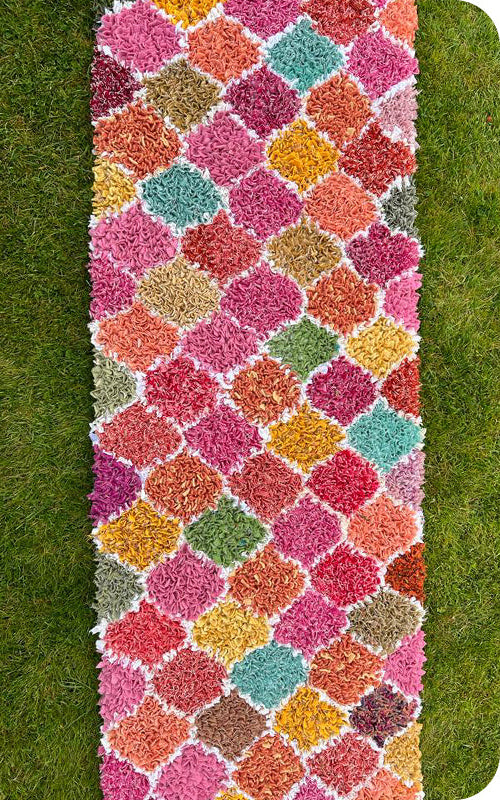

What is Recycled Sari Silk Ribbon?
Recycled sari silk ribbon is a gorgeous, eco-friendly textile made from the offcuts of traditional sari production in India. Instead of letting these vibrant fabric scraps go to waste, artisans hand-strip, twist, and sew them into long, flowing ribbons—each one bursting with rich colour and silky texture.
For rag rugging, sari silk ribbon is a dream to work with. Its soft, lightweight nature makes it easy to pull through hessian and other rug backings, while its luxurious sheen adds a unique touch of elegance to any project.
The natural variations in width and texture create a wonderfully organic, boho feel—perfect for adding character and charm to your handmade rag rug projects. Plus the fact that it comes in pre-cut strips means less time fabric-prepping and more time rug making!
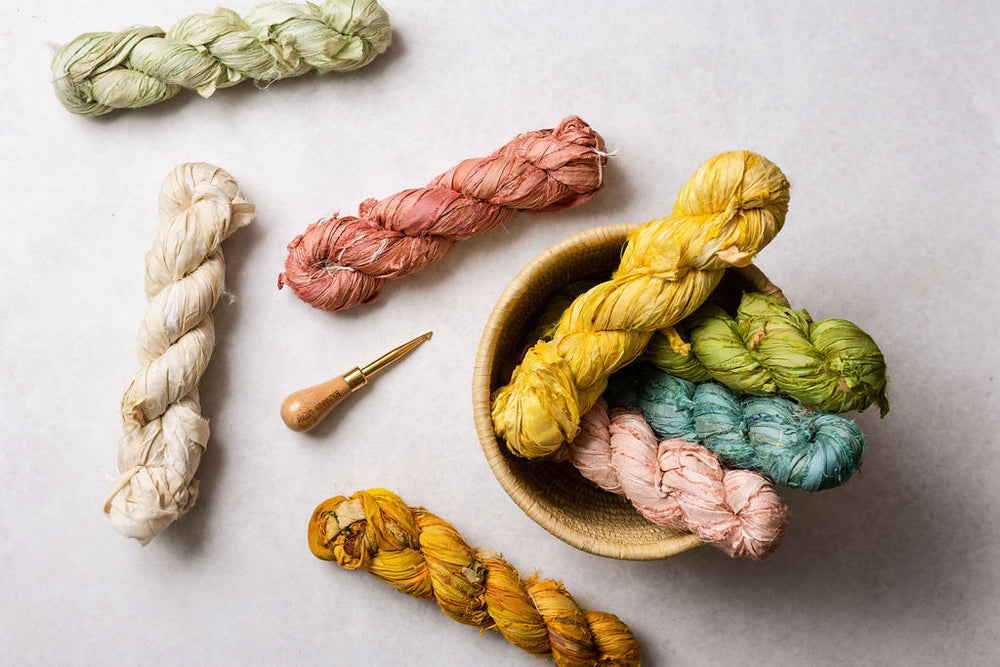
Key Features of Sari Silk Ribbon
We sell individual 100g skeins of recycled sari silk or 5 skein bundles in complementary colourways on the Ragged Life Online Shop.
Each of our 100g skeins contains approximately 50-60 metres of beautifully soft, silk strips, which measure around 2-3cm in width—the perfect width for weaving, rug hooking, progging, peg loom weaving or even crocheting. One of the joys of working with sari silk ribbon is its stunning variation in shade and texture within a single skein, making it look like you've done something fancy with no effort at all.
For more details on our sari silk ribbon, check out out our individual listings.
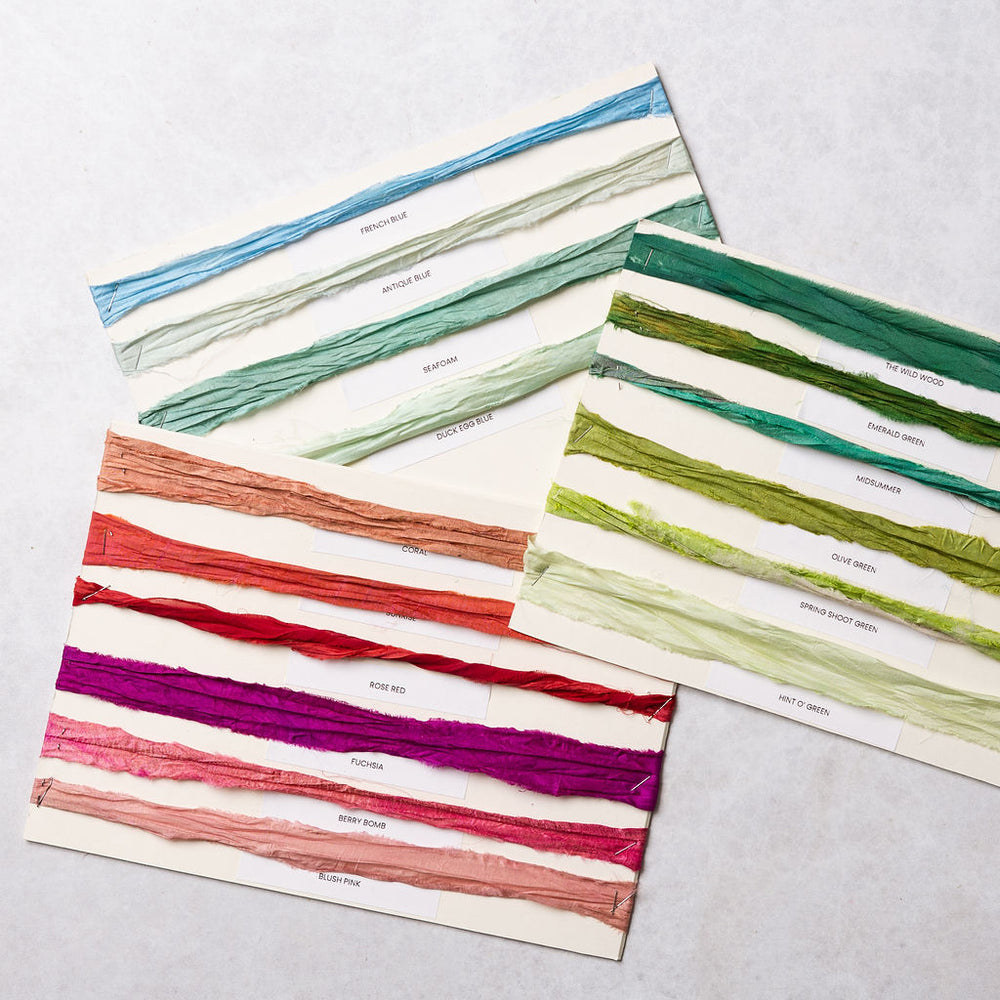
Get our FREE printable pattern pack
Sign up for our fortnightly rag rug inspiration newsletter below and receive a FREE Printable Pattern Pack with three beginner templates and designs to use for your first rag rug project, plus info about discounts and new products!

